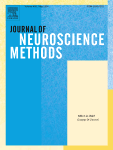
Publication date: Available online 16 January 2017
Source:Journal of Neuroscience Methods
Author(s): Kang-Hoon Je, Wi-Sun Ryu, Su-Kyoung Lee, Eo Jin Kim, Jeong-Yeon Kim, Hee Jeong Jang, Jung E. Park, Matthias Nahrendorf, Dawid Schellingerhout, Dong-Eog Kim
BackgroundWe have found that infarcted brain regions exhibit green channel autofluorescence (GCAF). Here, we compare ex vivo GCAF-imaging with 2,3,5-triphenylteterazolium chloride (TTC)-staining.New MethodC57BL/6 mice (n=120) underwent GCAF-imaging after transient or permanent middle cerebral artery occlusion (tMCAO or pMCAO).Comparison with Existing MethodsTTC-staining may not reflect subtle ischemic injury. TTC-stained tissues, when reused, are prone to processing artifacts related to prior TTC-staining. GCAF imaging requires little experimental manipulation of animals and brain tissues, and allows for more consistent measurements of infarct volume and reliable reuse of the fresh unstained tissues.ResultsLesion volumes measured at 24-hours after 1-hour tMCAO by using GCAF-images were similar to those using TTC-staining: 87.6±13.6mm
3 vs. 83.8±12.8mm
3 in 1mm-thick sections (n=9 mice, 10 slices/mouse, p=0.88; Pearson's r=0.91, p <0.001) and 75.1±7.6mm
3 vs. 73.6±6.7mm
3 in 2 mm-thick sections (n=9 mice, 5 slices/mouse, p=0.99; Pearson's r=0.87, p <0.001), respectively. In serial ex vivo imaging performed at 1, 2, 3, 6, 12, and 24-hours after tMCAO, GCAF-imaging correlated well with TTC-staining at all time-points. In the pMCAO model however, the correlation was strong at later time-points (6∼24-hours); but at time points up to 3-hours, GCAF-imaging was more sensitive than TTC-staining to detect ischemic areas, as verified by histology, where ischemic damage was observed in the GCAF-positive areas of the cerebral cortex and striatum, even in the face of normal TTC-staining.ConclusionGCAF-imaging is a reliable alternative to TTC-staining in the qualitative and quantitative assessments of focal brain ischemia, and more sensitive for detecting early ischemic damage in pMCAO.
http://ift.tt/2ixUC9n
